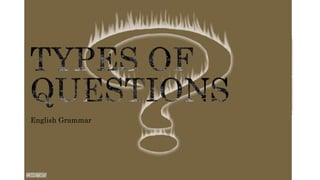
Types of Questions
- 2. Yes / No questions. Wh questions. Tag questions Embedded questions
- 3. A short answer (yes or no) is expected. Many of these questions are formedby putting an auxiliary verb before the subject (=inversion). Verb “to be” structure BE + SUBJECT + Adjective/Noun Do/Does structure DO/DOES + SUBJECT + VERB
- 4. Start with words like: What / Where / Why / Who / Whose / When /Which. WH questions with “do” structure. WH + DO/DOES + SUBJECT + VERB WH questions with “be” structure. WH + BE + SUBJECT Note: there are other question words that don’t start with "wh" as well. How / how many / how often / how far / how much / how long / how oldetc.
- 5. Short questions that appear at the end of some sentences usually to show emphasis, politeness, irony or lack of confidence. They are also used in informal and spoken English. Structure Main Clause + comma (,) + Positive/ Negative Auxiliary Verb + Personal Pronoun If main clause is positive He plays football, doesn't he? If main clause is negative He doesn’t play football, does he?
- 6. Remember that you should only use PERSONAL PRONOUNS in TQs: These cars are very comfortable, aren't these cars? NO These cars are very comfortable, aren't they?YES Mary is strikingly beautiful, isn't Mary? NO Mary is strikingly beautiful, isn't she?YES
- 7. Special case “I” Positive: I am French, aren't I? Negative I'm not Belgian, am I?
- 8. There are also other more informal tag questions. You told her, no? It is a nice car, innit? You have the tickets, right? He's a good buddy, eh? Clever, ain't it? Got some trouble, huh? You must not use them in formal language, they are perfect for some informal chats!
- 9. A little more formal and polite questions. We use them when talking to aperson we don’t know very well, or in professional situations. Their form is a little different. Example: Where is the train station? (Direct) Do you know where the train station is? (Indirect) Where is the bathroom? (Direct) Could you tell me where the bathroom is? (Indirect)
- 10. Could you tell me… Do you know… I was wondering… Do you have any idea… I’d like to know… Would it be possible… Is there any chance…
- 11. Rule One If the embedded question is part of a statement, use a period and not a question mark at the end of the sentence. Also, if the question is in the present or past simple verb tense, omit the auxiliary verbs do, does, and did and change the verbto its appropriate form. Direct Question What time did he leave? Embedded Question I wonder what time he left.
- 12. Rule Two If the embedded question includes an auxiliary verb or the verb "to be",reverse the positions of the subject and the auxiliary verb. Direct Question Embedded Question Direct Question Embedded Question Direct Question Embedded Question What did he say? Could you tell me what he said? Can you help me? I wonder if you could help me. Is he a doctor? Do you know if he is a doctor?
- 13. Rule Three Do not use a verbal contraction at the end of the sentence. Direct Question Where is she? Correct Embedded Question Do you know where he is? Incorrect Embedded Question Do you know where he's?
- 14. Rule Four Embedded questions are introduced by whether, whether or not, and if when there is not a yes/no question. Direct Yes/No Question Will he be there? Embedded Question Do you know if he will be there? Do you know whether or not he will be there? Do you know whether he will be there or not?
- 15. Rule Five The infinitive can follow a question word or whether in embedded questions. Direct Question What should I do? Embedded Question Would you tell me what I should do. Embedded Question with an Infinitive Would you tell me what to do.
